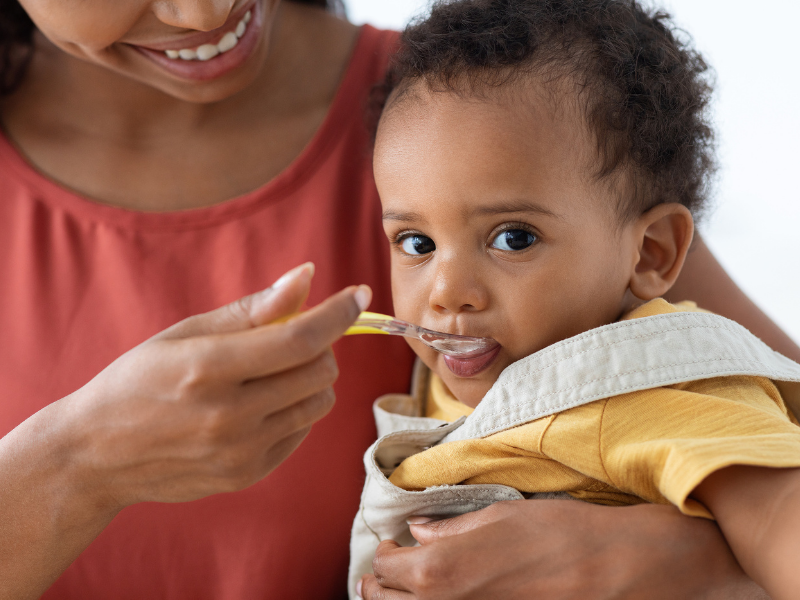Organic food has been all the rage the past few decades, but what does organic stand for? What standards do products need to meet to be considered organic? If you browse the baby food aisle in any store, you will notice that many of them are often labeled “organic,” however the term can be misleading.
In the winter of 2021, a congressional report that found dangerous concentrations of heavy metals lurking in seven major baby food brands was made public. It sparked outrage in parents across the country. Four of the seven companies have the word “organic” associated with their brand name: Beech-Nut, Earth’s Best Organic, Happy Family Organics and Plum Organics.
Therefore, baby food labeled “organic” does not equate to a safe or healthy product and can pose a health threat to your child. The primary threat is the presence of hazardous levels of cadmium, arsenic, lead and mercury in these products. Studies have shown a correlation between frequent exposure to heavy metals and impaired brain development, cardiovascular disease, cancer, diabetes and more. Once they reach the bloodstream, heavy metals act as neurotoxins and might severely and irreversibly damage the brain and the nervous system.
What Standards Must Baby Food Meet to Be Organic?
Lately, the term “organic” has been thrown around so often that it has almost lost meaning. However, for any food to be deemed organic, including baby food, it must contain 95% organic ingredients, whereas the remaining 5% can stem from non-organic sources.
According to the U.S. Department of Agriculture, there is food that is “more organic,” than others. This is dependent upon the percentage of organic ingredients present in the product.
- When food contains exclusively organic ingredients, it is labeled “100% organic.”
- When it contains 95%, which is the case with most foods, it is considered just “organic.”
- Food that has 75% or more organic ingredients, is labeled “made with organic ingredients.”
These distinctions are crucial and may help parents make better food choices for their children’s diets.
Nevertheless, when people read the word “organic” on the label of a baby food product, they associate it with higher quality and with natural, unadulterated ingredients. Some companies abuse the term or even use it when their food is far from organic. Moreover, people are buying increasingly more organic baby foods grown without hazardous pesticides, antibiotics or hormones. But does this mean the baby food is healthier? According to a study, consuming organic baby foods could reduce pesticide exposure, a source of heavy metals. Still, researchers could not find any other strong evidence that organic baby food is more nutritious than regular alternatives.
Ingredients Grown Organically Can Still Absorb Plenty of Heavy Metals
What differentiates organic agriculture from conventional agriculture is the lack of chemical and synthetic pesticides, artificial fertilizers, toxic insecticides, genetic manipulation and food irradiation. The absence of dangerous pesticides and insecticides significantly reduces the number of heavy metals absorbed by crops. But the plants still absorb cadmium, arsenic, lead, and mercury from water and soil, resulting in the finished products.
Unfortunately, this is inevitable unless more drastic agricultural practices become effective. Practices such as sourcing rice from fields with lower arsenic levels and growing it with natural soil additives that reduce arsenic uptake by the roots. Otherwise, rice, one of the most significant sources of arsenic in baby food, will continue to absorb up to 20 times more of this heavy metal than other crops. Therefore, one of the greatest health dangers baby food poses is their concentration of heavy metals which cannot be avoided even if you feed your child organic food.
Choosing the Best Food Alternatives for Your Baby
The presence of heavy metals in the vast majority of baby foods on the market is a reality that parents of infants and toddlers have to deal with for the moment, whether they like it or not. Agencies that should be strictly regulating the presence of cadmium, arsenic, lead and mercury in baby food, such as the Food and Drug Administration, are making progress too slowly in this respect. This leaves parents at a loss about what to feed their children to avoid a high concentration of toxic metals in their diet.
Luckily, there are practical measures you can take to reduce the level of heavy metals in your baby’s food, such as the following:
- Replace teething biscuits with frozen bananas to reduce the intake of heavy metals by 91%
- Choose the fish you feed your toddler carefully. Since it is a major source of mercury, you should avoid marlin, king mackerel, orange roughly, tilefish and ahi tuna and
- Instead give your child salmon, herring, trout or whitefish.
- Replace cereals that have rice with multigrain to reduce the concentration of heavy metals in food by 84%
- Pay attention to the rice intake of your baby by feeding it to your child sparingly and rinsing and cooking it in a lot of water that you should throw away once the food is ready to serve
Lastly, a beacon of hope would be the Baby Food Safety Act of 2021, which proposes safe limits for each of the four toxic metals of concern, where there are currently no limits. If it becomes law, parents will no longer have to worry about the content of heavy metals in baby food.
Related
Be Veggie Strong! 12 All-Stars Every Family Needs


